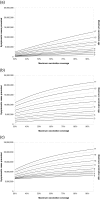The epidemiological impact of childhood influenza vaccination using live-attenuated influenza vaccine (LAIV) in Germany: predictions of a simulation study
- PMID: 24450996
- PMCID: PMC3905925
- DOI: 10.1186/1471-2334-14-40
The epidemiological impact of childhood influenza vaccination using live-attenuated influenza vaccine (LAIV) in Germany: predictions of a simulation study
Abstract
Background: Routine annual influenza vaccination is primarily recommended for all persons aged 60 and above and for people with underlying chronic conditions in Germany. Other countries have already adopted additional childhood influenza immunisation programmes. The objective of this study is to determine the potential epidemiological impact of implementing paediatric influenza vaccination using intranasally administered live-attenuated influenza vaccine (LAIV) in Germany.
Methods: A deterministic age-structured model is used to simulate the population-level impact of different vaccination strategies on the transmission dynamics of seasonal influenza in Germany. In our base-case analysis, we estimate the effects of adding a LAIV-based immunisation programme targeting children 2 to 17 years of age to the existing influenza vaccination policy. The data used in the model is based on published evidence complemented by expert opinion.
Results: In our model, additional vaccination of children 2 to 17 years of age with LAIV leads to the prevention of 23.9 million influenza infections and nearly 16 million symptomatic influenza cases within 10 years. This reduction in burden of disease is not restricted to children. About one third of all adult cases can indirectly be prevented by LAIV immunisation of children.
Conclusions: Our results demonstrate that vaccinating children 2-17 years of age is likely associated with a significant reduction in the burden of paediatric influenza. Furthermore, annual routine childhood vaccination against seasonal influenza is expected to decrease the incidence of influenza among adults and older people due to indirect effects of herd protection. In summary, our model provides data supporting the introduction of a paediatric influenza immunisation programme in Germany.
Figures






References
-
- Fairbrother G, Cassedy A, Ortega-Sanchez IR, Szilagyi PG, Edwards KM, Molinari NA, Donauer S, Henderson D, Ambrose S, Kent D, Poehling K, Weinberg GA, Griffin MR, Hall CB, Finelli L, Bridges C, Staat MA. New Vaccine Surveillance Network (NVSN) High costs of influenza: direct medical costs of influenza disease in young children. Vaccine. 2010;14:4913–4919. doi: 10.1016/j.vaccine.2010.05.036. - DOI - PubMed
-
- Poehling KA, Edwards KM, Weinberg GA, Szilagyi P, Staat MA, Iwane MK, Bridges CB, Grijalva CG, Zhu Y, Bernstein DI, Herrera G, Erdman D, Hall CB, Seither R, Griffin MR. New Vaccine Surveillance Network. The underrecognized burden of influenza in young children. N Engl J Med. 2006;14:31–40. doi: 10.1056/NEJMoa054869. - DOI - PubMed
Publication types
MeSH terms
Substances
LinkOut - more resources
Full Text Sources
Other Literature Sources
Medical

